|
Name |
Charlie Hutson PROSSER |
|
Birth |
Born in a tent on the night of 21st Nov, 1917 at Koonwarra Farm |
|
Death |
17 Jul 2003, Korumburra hospital Age: 85 |
|
Father |
Harry Hutson PROSSER (1895-1964) |
|
Mother |
Isabella Wood HAY (1898-1993) |
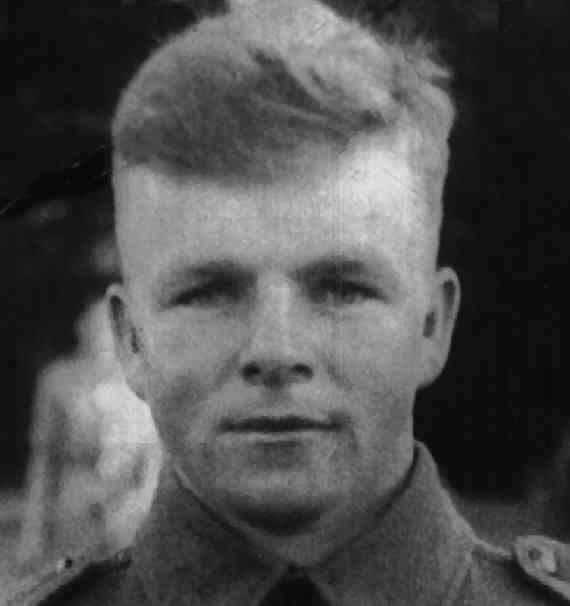
Spouses:
|
1 |
|
|
Birth |
17 Apr 1924 Age: 79 |
|
Occupation |
Dairy Farmer |
|
Education |
Primary School Horsley Rd, Korumburra South |
|
Father |
John "Jack" FARRELL (1887-1961) |
|
Mother |
Elizabeth Ann "Elsie" TIESLER (1890-1948) |
|
Children: |
Valma Doreen (1945-) |
|
|
Mervyn Charles (1947-) |
|
|
Elizabeth Anne (1949-) |
|
|
Harry Noel (1955-) |
Notes for Charlie Hutson PROSSER
Charlie Prosser
was born in a tent at Koonwarra, during the night of the 21st of
November 1917. His mother was assisted in the birth by her mother in
law Eliza Jane, who was a trained midwife. That morning, mother and
newborn were taken to Leongatha Hospital. Charlie's father Harry was a
Onion grower at Koonwarra. The family soon moved to Bowman's,
Koetsveldt Rd, Blackwood Forrest (Glen Alvie) and had a proper
roof aver there head for the first time. Charlie started his schooling
when he was 7 years old and finishing when 13, Charlie completed the 8
years/levels in just 6 years.
Yes,
those were the days, by Charlie Prosser
Here are some experiences of my
school days, plus those other doings by school friends and myself, and
a few which I and my family experienced. Perhaps the pranks were not
appreciated by our schoolteacher and certainly not by my father and
mother, Harry and Isie Prosser. With the exception of 14 days at
Blackwood Forest School, my entire schooling was at Krowera State
School. First a Miss Jessie Drohan, who taught me only for my first
year. Then the arrival of a young male teacher, Leslie N. James who saw
my school days through.

|
Back:
Jean Prosser, Mollie White, Jean McLaren, Hazel
McKenzie, Isla McKenzie, Lea White |
I started my Krowera schooling from the Bowman farm at Glen Alvie. Mother and father lived in the brown cottage on the corner. Lindsay and Elva, the 2 elder members of the McLaren family were my guardians over the 4 or 5 mile journey. Other members of the McLaren Jean and Gilbert also made up the group, meeting up with the Caldwell's on the way. having started school from Glen Alvie I had a big pony "Tottie", to ride to McLaren's then swapped Lindsay for a Shetland, "Blackie" and swapped back on the return. Tottie had a foal that was always locked home in a small paddock. Keen to get to get to her foal, she bolted this night and looked like clearing the gate, but at the last moment she baulked and propped. Thus, Charlie was air borne over the gate, landing quite some distance into the foal paddock. Yes, you are right, I could hardly sit on school desk seats for quite a while.
Shortly afterwards my family moved
to "Hazelmount" Krowera, and from there seven Prosser's attended
Krowera S.S.. I also attained my Merit certificate at the school and
can well remember the day I last move through the school gates, being
called back by Leslie N James and his remarks to me have been
remembered ever since. He spoke clearly saying "Charlie, if a district
is good enough for you to live in, always remember that the district
needs your help, so do give some thing back in service to help repay
the privilege of living there" - end of quote. Now my reflection, years
on is, "how true".
After school one afternoon I was
copping a decent belting from a bigger boy - ( I won't name him as he
is still bigger than me.) Having had enough I tried to escape over a
picket fence and ran part of a picket through my left knee and it
showed out behind my knee. Hence down to John McKenzie's, where Dad sat
on me while Mr Mac tried to pull it out with pliers. Not being
impressed I let out a scream. So we had a journey to Loch hospital. The
scar still remains.
The following story may have been
told before, but a good yarn can be worth repeating. "Boys will be
boys" as my good mates Tommy Caldwell and Gilbert McLaren and I found
out. Keeping an eye on fruit in Mr Stiley's large orchard, we decided
one Friday night the fruit would be ripe and gone by Monday, so we'd
get a few. The plan was for Charlie to get up the tree, Tommy to hold
the bag and Gilbert to keep watch. We were doing well when Gibby gave
warning to get going. Mr. Stiley was approaching with a long
horse-wagon whip. We were all off the mark, but as I tried to get over
the picket fence the heel of my boot caught in the pickets. Could hear
and feel the lash of the whip approaching, and with Gibby and Tom
urging me on, I finally lunged harder and off came the heel of the
boot. I had no sore parts to rube but had to make up an excuse for dad.
Not the truth, but it worked.
During the fruit season we passed
in front of Bob Wilson's house, as the new road alignment had cut their
orchard in two. Apples galore on the lower side of the road, hence a
short stop every night on our way home. When Maggie Wilson came out we
always had a good excuse "They're on the road", but Maggie never
relented.
Later at "Hazelmount" Krowera,
sister Jean was clearing weeds round the front door step of the house,
and came up with a black snake hanging on to her hand. We raced down to
the cowshed to tell Mum and Dad. Dad opened the wound, Mum sucked the
blood out and tied a tourniquet, and off to the doctor at Loch. No ill
effects, so back to school next day.
One Easter school break, Charlie set 40 rabbit traps, being not so big I had a billy cart to carry the traps. We left the cart under a big pine tree near Alex McKenzie's fence. At night dad and I set off, taking a hurricane lantern, to se how they trapped. On approaching the pine tree, we were confronted by a big Jersey bull, who was not happy at being disturbed from his night's resting spot. He looked threatening so dad and I shot up a willow tree in the gully, put out the lantern and waited. But every time we lit up to move on, the old bull used to come to see us again. You may imagine Mum's worries, as she could see no light and Dad and Charlie still not home after 3 hours. eventually a full moon appeared and a quick break for home was made. You're right, we only got two bunnies!
Having a big horse stable on top of the hill above the house. Dad had 5 draught horses stabled at night. He'd cut oaten hay with his hand chaff-cutter. having cut his chaff, while he was feeding his horses, sister Jean thought she'd have a ride on the chaff cutter handle. Over-balancing she put out her hand, but into the cutter mouth, hence she lost the top of number one finger. She let out a scream and Dad and I with a lantern searched in the chaff for the missing top of her finger. We found it and Dad stuck it back on and wrapped it up with a dirty old handkerchief. Though dad hadn't put it back too straight, nevertheless 50 odd years later its still doing its job.
We had fun with Loveday Thomson's geese. We kept bread crusts from school lunches tied to long string. Geese would swallow the bread and the fun began with those geese on a string. Yes, those were the days and as I said, "Boys will be boys and Girls will be Girls too." Good luck to Krowera State School for its Centenary. I hope to see many of the boys and girls of those years there.
1930's
The economic growth and optimism of
the 20's was soon to come to an end as Governments around the world
struggle to come to term's with capital shortages. The depression years
of the early 30's made life difficult for such a large family. With
cream prices at a record low, 5 pence/lb, down from 1s 4p/lb. Charlie's
father Harry was forced to obtain work with a road gang, spreading
bitumen with a hand shovel, on road project's in the Loch / Krowera
area for the next four years.
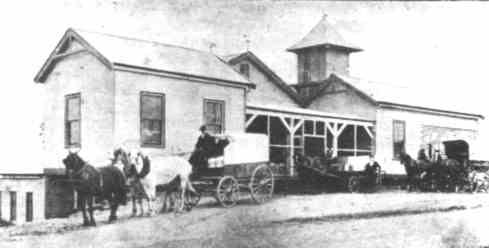
Bena Butter Factory, with white farm horse as above
Charlie continued to help after the family moved to Bena Rd, Korumburra, until he obtained a job as cream pick up driver for the Korumburra Butter Factory in 1938. The driver was often expected to be part baker or shopkeeper as they delivered many grocery items in the empty returned cream cans.
Charlie's friend Ernie Watt was dating a girl who had a younger sister, Gwen Farrell. Charlie invited Gwen to come along and make a foursome. Nights out together were usually spent going to local dance halls or the picture theatre. Gwen was to become the love of his life.
Also at this time an interest in football developed as first he played for the Korumburra Club and then Bena. The II World War was to interrupt and change his life.
World War II
Charlie enlisted in the army (AMF.) on 5th Dec 1939. Training in the AMF would be spasmodic and involved periods of intense training interlaced with normal civilian duties. Commenced basic training first at Caulfield Racecourse Army Camp in September 1940 and Broadmeadows.
[The other part of the army was
the Australian Military Force (AMF) or National Militia, which had a
few 'permanent soldiers' attached, but was otherwise composed of a mix
of enthusiastic volunteers (including WW1 veterans) and some 'national
service' draftees. The Militia's purpose was the defence of Australian
territory (and this included Papua, which had been a German colony
before the 1914-18 war). This political and geographic restriction led
to the AMF troops being ridiculed by the all-volunteer AIF as 'a
protected species - not available for export' or 'Chocolate Soldiers',
and other less polite terms.
In the pre-war period, Militia
units would have been kept under-strength and under-trained for
budgetary reasons. During 1939-1940, the best (young) Militia soldiers
volunteered for the adventure offered by the AIF, leaving the AMF very
short of energy and expertise. The ranks were then filled to wartime
strength with 17-19 year old conscripts. In general, the Militia units
of 1942 had limited training and no field experience. In a late effort
to improve the standard of these units, AIF officers were removed from
their own units and drafted into AMF battalions (replacing the older
AMF officers), to the dismay of both sides. Those new officers would
need a while before they could trust their men and be trusted by
them. AMF units were usually keen, but unskilled. In New
Guinea, they were used initially as labour or construction units, and
when called into battle, received a bloody and traumatic initiation.
Some rose to the challenge, whilst others found themselves unable to
cope with the stress and isolation of jungle warfare. By the time of
the end of 1942, a number of Militia units had been battle-tested at
places like Milne Bay, Kokoda and Oivi-Gorari. The rising level of
skill allowed AMF Brigades (and later, Divisions) to be successfully
employed against the Japanese in 1943-45 in New Guinea, New Britain,
and later Borneo. This was essential if Australia was to maintain a
viable army in the field when its manpower resources were stretched to
the limit.]
Before leaving Korumburra in 1941, Charlie had decided he had meet the women he wanted to marry, he asked his then young (17yrs) girlfriend to marry him should he return, she agreed. Charlie's unit was dispatched to Fisherman's Bend, the Dandenong Police Paddocks near Dandenong, and in April 1942, Mt Martha (Balcombe) in the 104th and 111th Reserve Motor Transport Unit for 6 months before returning to Caulfield . Charlie was part of the Australian Army Service Corps (AASC)
Between the wars 1919 - 1939
During this period the AASC (MSC) did not rate particularly high in military minds and consequently was reduced to a few militia units. The regular compliment of these units consisted mainly of small cadres of regular quartermasters and warrant officers of the Australian Instructional Corps. In 1933 a decision was made to mechanise the MSC and by 1938 the Corps was equipped with Chevrolets, 30cwt for second (formation) line work and 3 ton for third (force) line work. The total MSC Motor Transport vehicles in 1939 were approximately 100. Prior to World War Two the MSC was prepared neither in numbers nor equipment for wartime tasks and was largely untrained in almost every aspect of its specialist functions. Units possessed few vehicles and most of these were outdated and unsuitable, equipment was at a premium. There were no depots for supplies, only inadequate drill halls and makeshift buildings. During the war the AASC (MSC) saw service on all fronts.
Now in the 135th General Transport Unit, this would become Charlie's home unit. Friend's made in the 135 were to be some of Charlie's most prized, and would last him a lifetime. He would meet with them several times a year, with services for those departed held at the 'Shrine Of Remembrance'. Informal gatherings over a few beers on football Grand Final night or invited up to the farm at Bena, when family and kids were welcome. Charlie marched in the Anzac Parade with his mates, almost without fail, until he got too old to travel. " The 135 Australian General Transport Unit has its own plaque at the base of a tree on the western edge of the 'Shrine Of Remembrance' forecourt. WE WILL REMEMBER THEM.
Not all training was for war, good luck or very skilled at a game of "two up" would see Charlie win a considerable amount of money. This was later stolen on the way home by some tipped off criminals.

Police Paddocks near Dandenong - weapons training took place in this area during the war.
In 1942 a military training camp was placed at Rowville, about 2kms to the north, the site which later became the electricity terminal station. It accommodated tactical response Australian troops, American troops destined for war in the islands north of Australia, and finally prisoners of war. The Camp had a relatively short history as a military camp and was only in use from 1942 until 1946. During that time it was first used by the 3rd Motor Brigade Group on 18th May 1942. The troops stationed there included signallers, ambulance drivers and engineers. Units of these groups were engaged in training and exercises. The troops were stationed in the Rowville Camp because of the concern at the time that the Japanese might land in the Westernport Bay area. They were to be used as a mobile tactical reserve to reinforce troops defending the coast between Westernport Bay and Point Nepean. The Units stationed in the coastal area were under the command of Brigadier George H. Knox and the Units at Rowville were under the command of Brigadier K.A. McKenzie.[*]
The first huts in the Balcombe Army Camp were erected in 1939. The area is now called Balcombe Estuary. The Footscray Regiment, machine gunners lived in the first houses while the militia lived in tents.
Balcombe Army Camp Gates
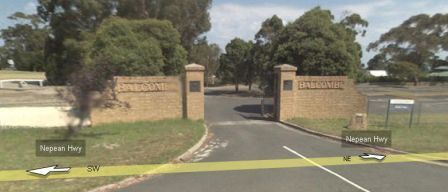
The 1st Division US Marine Corps and the ‘SeaBees’, Construction Brigades then moved into Balcombe. One estimate was 30,000 men. The Marines would carry out practice beach landings from the "Manoora" near the Dromana cliffs. The Australian Signals and the Survey Corps eventually took over Balcombe Camp. The former Balcombe Army Camp was used by the Australian Army as a training area and by the 1st Division United State Marine Corps for R&R following the Battle of Guadalcanal during World War 2. Shire of Mornington Council, on 18 January 2000, considered a request from the 1st Marine Division Association, Virginia, USA, for Council to preserve the Memorial Gates at the former Balcombe Army Camp at Mount Martha in their current location on Nepean Highway.
Charlie's 135th Aust. Gen. Trans. Unit was posted to AASC. N.S.W. Sydney in March 1943. Here he spent some time with the 1st Brigade HQ. The brigade was assigned to training and defensive duties in south eastern Australia. It continued in this role throughout the Second World War. Then spent time at the 115 Independent Brigade Group Ordnance Field Park, Pt Bulk Issue Petrol And Oil Depots (BIPOD) and the 2 Australian Army Ordinance Unit (2 AAOD). A short period was spent in the 12 Camp Hospital at the showgrounds being treated for a skin infection
.
|
Service Record for AIF (prior AMF service not yet listed) |
|
|---|---|
|
PROSSER, CHARLIE HUTSON |
|
|
Australian Army |
|
|
VX146221 |
|
|
21 Nov 1918 |
|
|
KORUMBURRA, VIC |
|
|
5 Dec 1943, enlisted in the field, Sydney |
|
|
KORUMBURRA, VIC |
|
|
IN THE FIELD, VIC |
|
|
PROSSER, HARRY |
|
|
15 Aug 1944 |
|
|
Private |
|
|
135 AUSTRALIAN GENERAL TRANSPORT |
|
|
No |
|
Darwin
Eventually the 135th Aust.Gen.Trans.Unit was posted to Darwin on the 18th Feb, 1944. The unit left from Sydney aboard the HMAS MV Duntroon . Japanese submarines were known to be off the east and northern coast of Australia. The Duntroon was a former passenger ship belonging to the Melbourne Steamship Company. She had been called up for the duration, was camouflaged all over, and had been armed with a large gun in a steel turret, some rockets and, on the after deck, several anti-aircraft devices. Her average speed would be about 15 knots and it would take about 10 days to get to Darwin. This was a more dangerous route even with escorts. Mines off the coast were a constant hazard. Rains in Central Australia had made the roads unpassable, so the sea was the only available route.

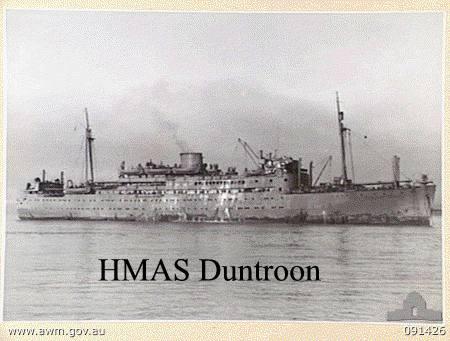

SHIPS
ATTACKED OFF THE AUSTRALIAN COASTLINE
BY JAPANESE SUBMARINES
Base camp was at the 12-mile mark from Darwin in order to avoid Japanese bombing raids. Work involved trucking supplies from Adelaide River 70 miles south to units further forward or Darwin itself. Promoted for a brief time, Charlie quickly lost it when he was found to have "signed in" a mate, who was involved in a MCA that night. By the end of 1944 the war had moved north into the Pacific and South East Asia and some solders including Charlie were called back to their civilian jobs. Finished service 15th August 1944.

Darwin, Australia. 1944-09-08. Members of 135 General Transport Company, Australian Army Service Corps during a march past of transportation units on Melville Oval. The salute was taken by NX2 Major General A S Allen CB CBE DSO VD.
BENA
FARM, SOUTH GIPPSLAND HIGHWAY
Now
Charlie could
marry the woman he had become engaged to nearly 5 years earlier, Gwen
Farrell. Charlie continued to drive milk can trucks and he and his new
wife set up house in Bena Rd Korumburra. His football sporting life was
to resume for a short time until a job change (farming) finished it.
Cricket would continue right up till his mid 50's. Just before their
second child was born, the Prosser family commenced share farming on
"Digger" Farrell's dairy farm on the Princes Highway at Bena in
1947. Living out of town required wheels a a popular British car
was the norm, A Vauxhall 12,
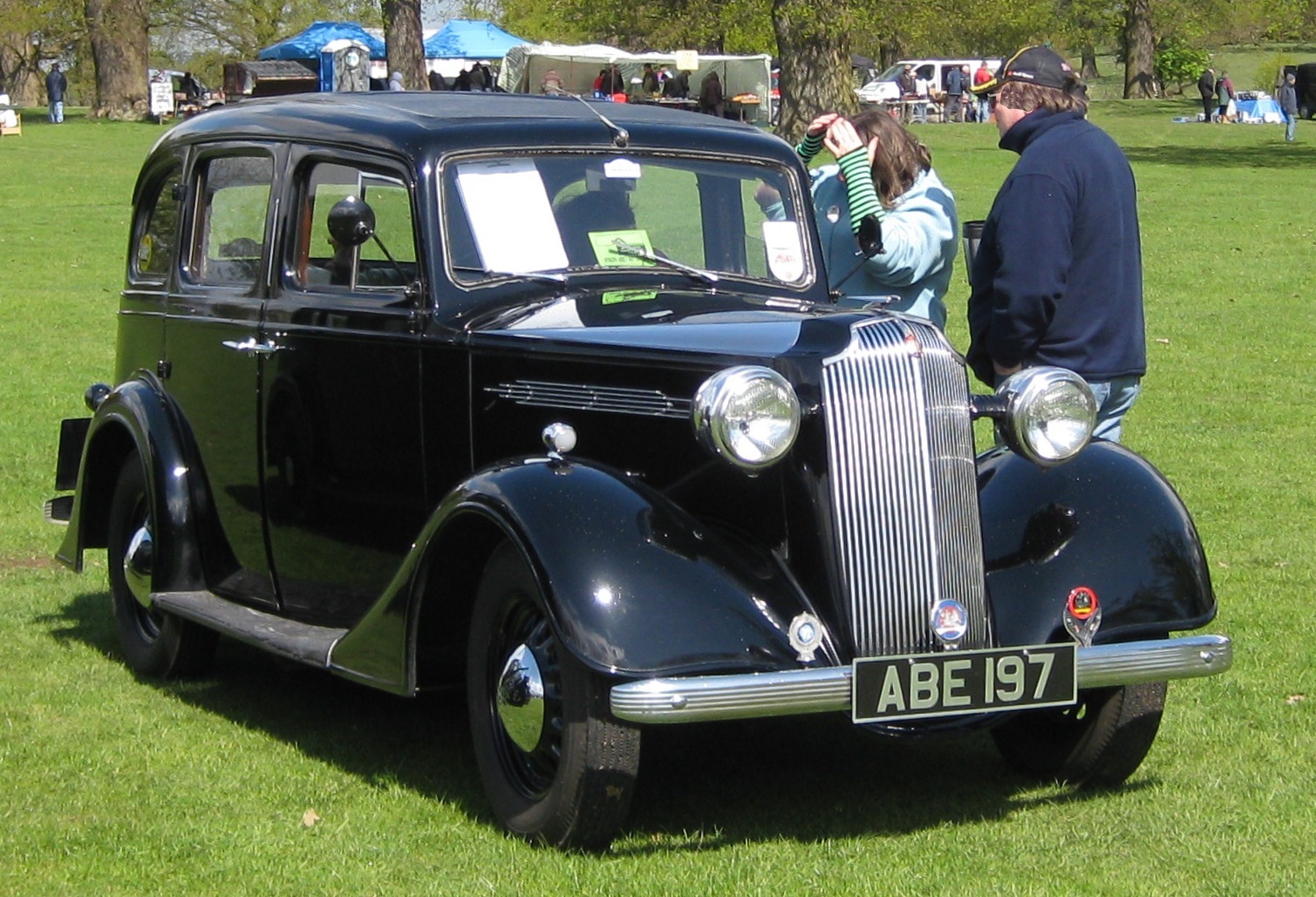
The income from farming would allow
Charlie to upgrade his then current car to to a classic UK car, the
Vauxhall Velox PA Saloon 1958. Yes the colour was two tone black and yellow as shown.
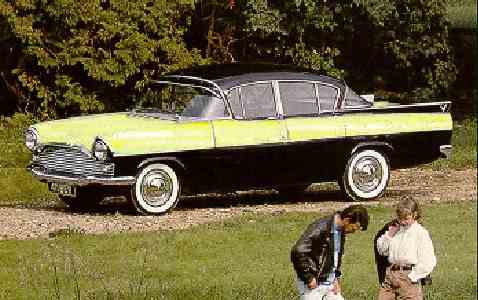
Charlie and Gwen were share farming on her brothers farm, and were asked to do many tasks not directly related to there own income. Clearing the land of old trees, helping with potato crops. Remnants of huge old Eucalyptus tree dotted the landscape. The farm was in an area of one of Victoria's greatest forests, cleared by timber cutters and settlers. I well remember dad burning the stumps from the ground. Although we had a grey Massey Ferguson tractor, two shire draught horses were also used. The could go places with a sledge that motorized tractors still could not, especially thru the muddy gullies. They could pull the sledge and driver up hills a tractor could note for fear of turning over. The horses were retired when the farm tracks were able to cope with constant tractor use. Charlie had a Melbourne milk contract, which meant he was required to supply milk every day of the year. Morning and night, no days off for years, except short breaks in winter. After the winter downturn, the dairy farm would come into maximum production as cows gave birth in spring and thus producing milk. Late spring paddocks could be locked up to allow grass to grow for harvest as either silage or hay which was cut in December and January. This busy schedule was only really able with the support of Charlie's wife Gwen who assisted in the milking shed and Charlies oldest son 'Merv'. The grey 'fergy' tractor was put to work cutting the grass contract harvester's would do the rest. Building a silage stack was a family affair with pitch forks used to distribute the load. Hay bailing was always done by uncle 'Digger' Farrell who was one of the first in the district to own a hay bailer. My first ever payed employment was driving the rake tractor pushing the grass into rows. At the end of summer, last years silage was feed out with pitch forks from the back of a trailer. The unique smell of silage (cooked grass) will never be forgotten. Winter months would involve distributing the thousands of hay bails stored during the summer. Getting about the farm to put the hay out was a journey in itself. The farm had one very steep spine almost across the middle. To get down from this to the back of the farm required long and twisted trip along mud potted tracks and creek crossings. Autumn rains brought more grass that could be strip grazed using portable electric fencing, especially on paddocks cut for hay. Some years paddocks were ploughed for seasonal crops such as turnip or maze to be feed to the herd in strip grazing, before being resewn as pasture. Paddock gates were always of the home made wire variety. A journey on the back of the fergy was always a physical challenge as Charlie could start or stop the tractor sending any inattentive passenger tumbling off. The farm of 110 acres was not financially viable without the leasing of more land in the nearby Jeetho district. Neighbours land on either side was leased at various times, with the flat land near the Jeetho Hall being the last before he retired to Warragul Rd, Korumburra.
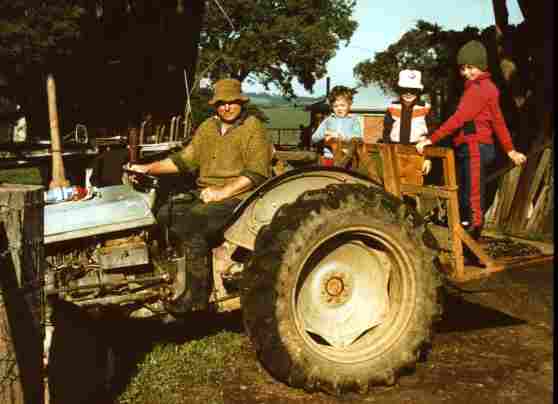
With Fergy & Grandchildren
The family increased in size to a
total of four children by 1955.
With prospect of good returns, Charlie
and Gwen, purchased the farm at Bena from his brother in law in the mid
1960's. A new car, VC Valiant Regal with heater, radio, and automatic
transmission was purchased in 1967.

But times were to change, at first a very severe drought occurred and then world prices for butterfat dropped. Payments for the farm were difficult and rather than loss the farm or stop payment to his brother in law, money was borrowed from the bank. Difficult financial times had arrived again, not that I was really aware of it. Farm life is not one that requires a lot of money, as it has activities and freedoms that city people can only dream of. Opportunities to live outdoors, in a beautiful environment. The Farm at Bena was certainly a most beautiful place, amongst the rolling hills of South Gippsland.

A lifetime on the farm was not the only pursuit, many evenings were spent working for his local community in honorary rolls. I find the following list very impressive.
|
Secretary Jeetho State School |
5 years |
|
President Committee Jeetho School |
3 years |
|
Bena Hall Committee member |
30 years |
|
President Bena hall Committee |
3 yrs |
|
Treasurer Bena hall Committee |
6 yrs |
|
President Jeetho Hall Committee |
3 yrs |
|
Member Jeetho Hall Committee |
23 yrs |
|
Member Bena Cricket Club |
43 yrs |
|
Secretary Bena Cricket Club |
41 yrs |
|
Treasurer Bena Cricket Club |
40 yrs |
|
Captain Bena Cricket Club (3 Premierships) |
10 yrs |
|
Member Bena Football Club |
60 yrs |
|
President Bena Football Club |
5 yrs |
|
Selection committee Bena Football Club |
3 yrs |
|
Committee Bena Football Club |
13 yrs |
|
Delegate Bena Cricket Club (R.C. Assoc) |
20 yrs |
|
Secretary Rancby Cricket Association |
2 yrs |
|
Selector Rancby Cricket Association |
7 yrs |
|
President Jeetho Branch A.P.P.U. then Loch |
43 yrs |
|
President Zone 22 Vic. Farmers Federation |
6 yrs |
|
Delegate Whole Milk Zone 22 to Melb. |
5 yrs |
|
President Zone 22 V.F.F. Leongatha |
6 yrs |
|
Delegate Jeetho Loch V.F.F. |
39 yrs |
|
President Loch R.S.L. |
2 yrs |
|
Delegate District Board 41 R.S.L. |
4 yrs |
|
President 135 General Transport Unit |
7 yrs |
|
Committee 135 General Transport Unit |
26 yrs |
|
Delegate Bena Football Club to the Assoc. |
3 yrs |
|
Committee Back to Krowera School Celebration |
|
|
Committee Back to Jeetho Celebration |
|
|
Life Governor Masonic Homes |
|
|
50 yr Jewel Korumburra Masonic Lodge |
|
|
Member Korumburra Masonic Lodge |
50 yrs |
|
Member Korumburra Senior Citizens |
9 yrs |
|
President Korumburra Senior Citizens |
8 yrs |
|
Member Australia Day Committee |
|
|
Member Korumburra Centenary Group |
|
|
Member Korumburra Karmi Festival Committee |
|
|
Member back to Korumburra Sth Committee |
|
|
Senior Goal Umpire Bena & Bass Valley League |
|
|
Finals Goal Umpire |
|
|
Football writer and commentator local paper |
Many yrs |
|
Red Cross Collector |
Many yrs |
Sport
A love of sport and sporting people would also describe Charlie. He was no football champion, but as a sport administrator, he was dedicated and respected as above. He was still able to play cricket till his mid fifties, and could still take a wicket or two. Was rewarded for even taking a hat trick at bowling slow spin. The boot of the family car always had a full club set of cricket bats and pads in summer. The groceries or whatever would have to share the space. I never had any problems with lack of gear to practice with, just go to the car boot. Whether it was collecting money at the gate, goal umpiring , time keeper, dad was always there. Players can never know what dedication happens in the background so we can have the limelight. Thank you to anybody who has had this roll, we owe you an awful lot, thankyou.
Travelling to and from sporting events was an exploration of the district. As football games were played in a diverse number of locations, different roads were used for different games. Travelling south from Bena would take us thru the districts of Phillip Island, Bass, Dalyston, Archies Creek, Inverloch, Wonthaggi, Kongwak, Glen Alvie, Krowera, Woodleigh, Loch, Kilcunda Road, and everywhere in between. The roads were twisted and narrow as they weaved there way thru the hills.
See District map (but ignore fictional rail)
If we missed anything here, then a drive on Sunday to explore further. Charlie seemed to know who lived on every farm. This came from his days as a milk truck driver who covered every route for the Korumburra Butter Factory.
Blackberries and Plums
The farm was blessed with an orchard that was planted by a much earlier owner. Plum trees, apple's, pear and fresh walnut were a seasonal gift. Excess fruit was always given out to other family members, especially his sister Jean, as she had a big family to feed. Gwen could turn those plums into the most delicious jam and plum pudding will never taste the same without them. Autumn would also bring a harvest of mushrooms, which dad loved for breakfast with eggs and toast. The eggs came from the pen of farm chickens, locked away at night to stop district foxes from getting to them at night. Our next door neighbours where never good at clearing blackberries, especially down one hill. Vast hedges of berries could be harvested by stepping over the fence into the forest of berries. Rabbits liked to hide there burrows here as well, and one of my earliest memories is walking the hills at night to visit rabbit traps set where the rabbits would travel thru the fences. If the traps weren't visited in time, the rabbit could escape or end up as feed for local foxes. Occasionally the fox would find itself caught in another trap. A kerosene lamp dimly lighting the way ahead. Latter my brother Merv would use ferrets to chase the rabbits out of there borrows into waiting nets. Sometimes we would have to come back looking for the ferret that was to busy feeding to come out. Dad never owned a gun and I never saw him use one, although I'm sure the army taught him how to use one. Occasionally neighbours would be invited to spotlight at night, looking for rabbits and foxes who became stunned in the bright light. Myxomatosis, a contagious rabbit virus, reduced the need to do either. Native wildlife was not abundant as the land had been cleared of its magnificent forest, but native snakes still made a home, along with the odd Koala. Bird species were dominated by the Magpie and Kookaburra. Farm cats in abundance kept the mice and rat numbers down near the farm sheds. These cats, with there many offspring, supported by Gwen feeding them with fresh milk from the dairy. The favourite mother cat invited into the house for scraps and warmth.
A Mans Shed
Sheds on the farm were made of galvanized iron and were always home made. The cow or milking shed was a standard walk thru with ten cow bails. Each cow was feed during milking by the turn of a long handle. Some cows had discovered if they gave the feed bin a head butt they could feed themselves. Loading the feed bins was back breaking work hauling large bags from distant sheds to be later manually loaded up. If a cow was sick or having difficulty calving, the cow shed could be used as an operating or delivery suite. An old tube radio was always on in the background with music and news. Sheds closer to the house were part museum, old farm implements and furniture. Garage for tractors, trailers, mowers, spreaders, cow feed and sometimes hay. The last shed was a tool shed and work bench. Charlie's tools were never new, probably half worn out, but he could maintain things working with the most limited range. Any wooden structure cold be knocked up using timber salvaged from the farms original wooden house. Next came the wood pile of timber from dead, often Blackwood trees from around the farm. I think Charlie went deaf cutting this timber with a large circular bench saw without the use of ear muffs. The high pitch scream from the blade was awful to listen to at even greater distances. Next to this was the coal briquettes, a short 20 meters to get them to the house. The final shed, called the "wood shed", never ever had wood in it. It was the junk shed for everything you wanted to get out of the house, mostly magazines and papers.
Can I end this part of his life
with memory Charlie had of his last day of school. "Charlie, if a
district is good enough for you to live in, always remember that the
district needs your help, so do give some thing back in service to help
repay the privilege of living there". I think he carried that with him
for the rest of his life. Many men are rewarded with honours for their
service to their country by becoming famous or wealthy. Charlie was
neither of these, but Australia has many fine citizens like him, who
are the true back bone of the country and community. Their reward is a
life well lived.